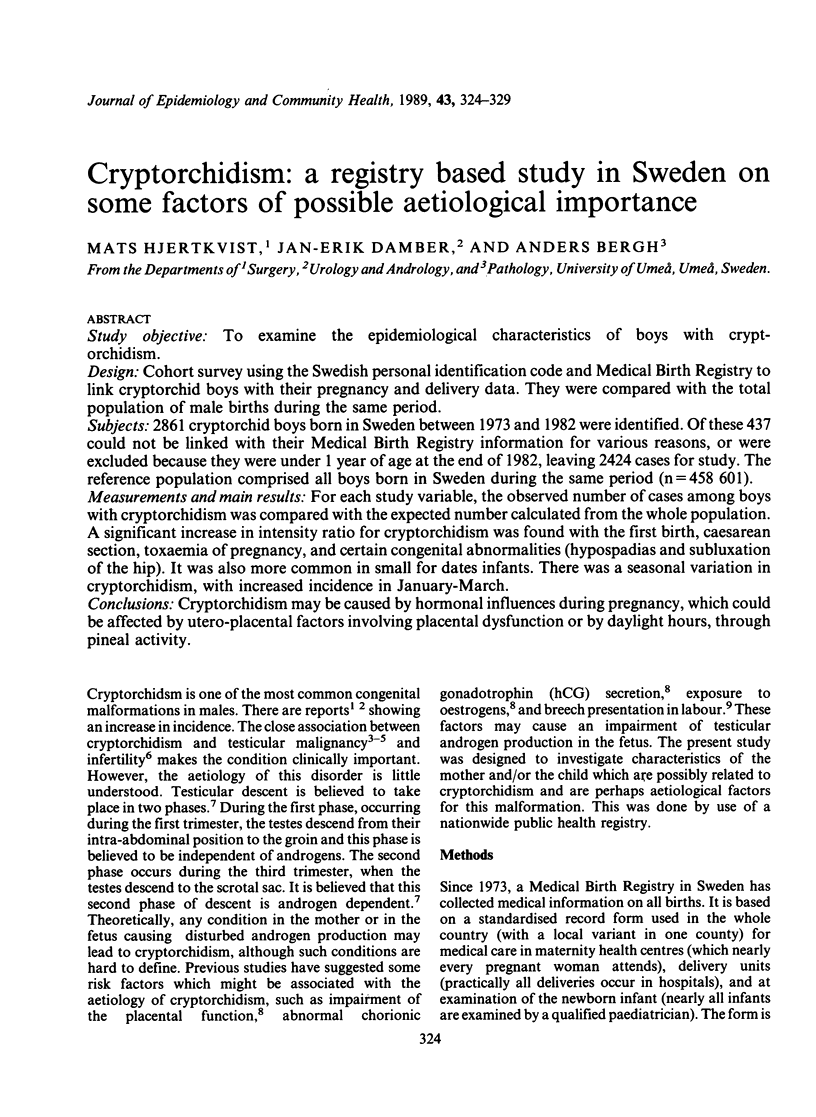Abstract
STUDY OBJECTIVE: To examine the epidemiological characteristics of boys with cryptorchidism. DESIGN: Cohort survey using the Swedish personal identification code and Medical Birth Registry to link cryptorchid boys with their pregnancy and delivery data. They were compared with the total population of male births during the same period. SUBJECTS: 2861 cryptorchid boys born in Sweden between 1973 and 1982 were identified. Of these 437 could not be linked with their Medical Birth Registry information for various reasons, or were excluded because they were under 1 year of age at the end of 1982, leaving 2424 cases for study. The reference population comprised all boys born in Sweden during the same period (n = 458,601). MEASUREMENTS AND MAIN RESULTS: For each study variable, the observed number of cases among boys with cryptorchidism was compared with the expected number calculated from the whole population. A significant increase in intensity ratio for cryptorchidism was found with the first birth, caesarean section, toxaemia of pregnancy, and certain congenital abnormalities (hypospadias and subluxation of the hip). It was also more common in small for dates infants. There was a seasonal variation in cryptorchidism, with increased incidence in January-March. CONCLUSIONS: Cryptorchidism may be caused by hormonal influences during pregnancy, which could be affected by utero-placental factors involving placental dysfunction or by daylight hours, through pineal activity.
Full text
PDF





Selected References
These references are in PubMed. This may not be the complete list of references from this article.
- Barbieri R. L., Saltzman D., Phillippe M., Torday J. S., Randall R., Frigoletto F. D., Ryan K. J. Elevated beta-human chorionic gonadotropin and testosterone in cord serum of male infants of diabetic mothers. J Clin Endocrinol Metab. 1985 Nov;61(5):976–979. doi: 10.1210/jcem-61-5-976. [DOI] [PubMed] [Google Scholar]
- Beard C. M., Melton L. J., 3rd, O'Fallon W. M., Noller K. L., Benson R. C. Cryptorchism and maternal estrogen exposure. Am J Epidemiol. 1984 Nov;120(5):707–716. doi: 10.1093/oxfordjournals.aje.a113938. [DOI] [PubMed] [Google Scholar]
- Burton M. H., Davies T. W., Raggatt P. R. Undescended testis and hormone levels in early pregnancy. J Epidemiol Community Health. 1987 Jun;41(2):127–129. doi: 10.1136/jech.41.2.127. [DOI] [PMC free article] [PubMed] [Google Scholar]
- Chilvers C., Pike M. C., Forman D., Fogelman K., Wadsworth M. E. Apparent doubling of frequency of undescended testis in England and Wales in 1962-81. Lancet. 1984 Aug 11;2(8398):330–332. doi: 10.1016/s0140-6736(84)92697-7. [DOI] [PubMed] [Google Scholar]
- Davies T. W., Williams D. R., Whitaker R. H. Risk factors for undescended testis. Int J Epidemiol. 1986 Jun;15(2):197–201. doi: 10.1093/ije/15.2.197. [DOI] [PubMed] [Google Scholar]
- Depue R. H. Maternal and gestational factors affecting the risk of cryptorchidism and inguinal hernia. Int J Epidemiol. 1984 Sep;13(3):311–318. doi: 10.1093/ije/13.3.311. [DOI] [PubMed] [Google Scholar]
- EDWARDS J. H. The recognition and estimation of cyclic trends. Ann Hum Genet. 1961 May;25:83–87. doi: 10.1111/j.1469-1809.1961.tb01501.x. [DOI] [PubMed] [Google Scholar]
- Heikinheimo M., Seppälä M. Amniotic fluid human chorionic gonadotropin in late pregnancy: elevated levels in toxemia with intrauterine growth retardation. Am J Obstet Gynecol. 1983 Aug 1;146(7):766–768. doi: 10.1016/0002-9378(83)91074-8. [DOI] [PubMed] [Google Scholar]
- Henderson B. E., Benton B., Jing J., Yu M. C., Pike M. C. Risk factors for cancer of the testis in young men. Int J Cancer. 1979 May 15;23(5):598–602. doi: 10.1002/ijc.2910230503. [DOI] [PubMed] [Google Scholar]
- Hutson J. M. A biphasic model for the hormonal control of testicular descent. Lancet. 1985 Aug 24;2(8452):419–421. doi: 10.1016/s0140-6736(85)92739-4. [DOI] [PubMed] [Google Scholar]
- Jackson M. B., Swerdlow A. J. Seasonal variations in cryptorchidism. J Epidemiol Community Health. 1986 Sep;40(3):210–213. doi: 10.1136/jech.40.3.210. [DOI] [PMC free article] [PubMed] [Google Scholar]
- Jarrige J. F., Tlemcani O., Boucher D. Gonadal function in male offspring of pinealectomized female rats. Acta Endocrinol (Copenh) 1987 Oct;116(2):247–252. doi: 10.1530/acta.0.1160247. [DOI] [PubMed] [Google Scholar]
- Kauppila A., Kivelä A., Pakarinen A., Vakkuri O. Inverse seasonal relationship between melatonin and ovarian activity in humans in a region with a strong seasonal contrast in luminosity. J Clin Endocrinol Metab. 1987 Nov;65(5):823–828. doi: 10.1210/jcem-65-5-823. [DOI] [PubMed] [Google Scholar]
- Knox E. G., Cummins C. Birth dates of men with cancer of the testis. J Epidemiol Community Health. 1985 Sep;39(3):237–243. doi: 10.1136/jech.39.3.237. [DOI] [PMC free article] [PubMed] [Google Scholar]
- Krabbe S., Skakkebaek N. E., Berthelsen J. G., Eyben F. V., Volsted P., Mauritzen K., Eldrup J., Nielsen A. H. High incidence of undetected neoplasia in maldescended testes. Lancet. 1979 May 12;1(8124):999–1000. doi: 10.1016/s0140-6736(79)92754-5. [DOI] [PubMed] [Google Scholar]
- Källén B. Hyperemesis during pregnancy and delivery outcome: a registry study. Eur J Obstet Gynecol Reprod Biol. 1987 Dec;26(4):291–302. doi: 10.1016/0028-2243(87)90127-4. [DOI] [PubMed] [Google Scholar]
- Pottern L. M., Brown L. M., Hoover R. N., Javadpour N., O'Connell K. J., Stutzman R. E., Blattner W. A. Testicular cancer risk among young men: role of cryptorchidism and inguinal hernia. J Natl Cancer Inst. 1985 Feb;74(2):377–381. [PubMed] [Google Scholar]
- Svensson J. Male hypospadias, 625 cases, associated malformations and possible etiological factors. Acta Paediatr Scand. 1979 Jul;68(4):587–592. doi: 10.1111/j.1651-2227.1979.tb05060.x. [DOI] [PubMed] [Google Scholar]
- Swerdlow A. J., Huttly S. R., Smith P. G. Prenatal and familial associations of testicular cancer. Br J Cancer. 1987 May;55(5):571–577. doi: 10.1038/bjc.1987.116. [DOI] [PMC free article] [PubMed] [Google Scholar]
- Swerdlow A. J., Wood K. H., Smith P. G. A case-control study of the aetiology of cryptorchidism. J Epidemiol Community Health. 1983 Sep;37(3):238–244. doi: 10.1136/jech.37.3.238. [DOI] [PMC free article] [PubMed] [Google Scholar]


